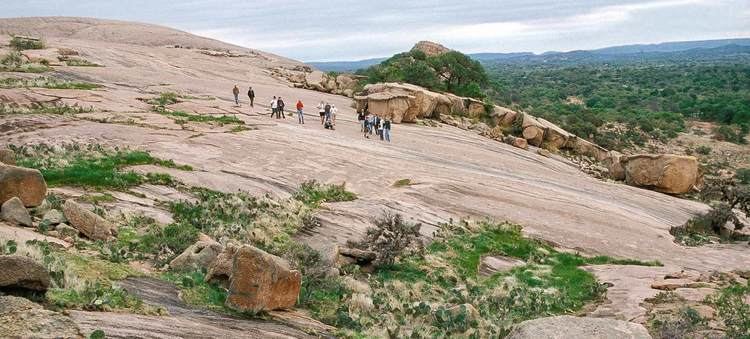Elevation 1,825 ft (556 m) Designated 1971 | Mountain type granite dome | |
 | ||
Location Llano County, Texas, US Similar Pedernales Falls State Park, National Museum of the Pacifi, Hamilton Pool Preserve, Longhorn Cavern State Park, Old Tunnel State Park | ||
Enchanted Rock (16710 Ranch Rd 965, Fredericksburg TX) is an enormous pink granite pluton batholith located in the Llano Uplift approximately 17 miles (27 km) north of Fredericksburg, Texas and 24 miles (39 km) south of Llano, Texas, United States. Enchanted Rock State Natural Area, which includes Enchanted Rock and surrounding land, spans the border between Gillespie County and Llano County, south of the Llano River. Enchanted Rock covers approximately 640 acres (260 ha) and rises approximately 425 feet (130 m) above the surrounding terrain to elevation of 1,825 feet (556 m) above sea level. It is the largest such pink granite monadnock in the United States. Enchanted Rock State Natural Area, a part of the Texas state park system, includes 1,644 acres (665 ha). Designated a Recorded Texas Historic Landmark in 1936.
Contents
- Map of Enchanted Rock Texas 78643 USA
- GeologyEdit
- HistoryEdit
- LegendsEdit
- Flora and faunaEdit
- Enchanted Rock State Natural Area and ConservationEdit
- Additional readingEdit
- References
Map of Enchanted Rock, Texas 78643, USA
GeologyEdit
The prominent granite dome is visible for many miles in the surrounding basin of the Llano Uplift. The weathered dome, standing above the surrounding plain is known to geologists as a monadnock. The rock is actually the visible above-ground part of a segmented ridge, the surface expression of a large igneous batholith, called the Town Mountain Granite of middle Precambrian (1,082 ± 6 million years ago) material that intruded into earlier metamorphic schist, called the Packsaddle Schist. The intrusive granite of the rock mass, or pluton, was exposed by extensive erosion of the surrounding sedimentary rock, primarily the Cretaceous Edwards limestone, which is exposed a few miles to the south of Enchanted Rock.
HistoryEdit
Archaeological evidence indicates human visitation at the rock going back at least 11,000 years.
According to the book The Enchanted Rock published in 1999 by Ira Kennedy
These hunter-gatherers had flint-tipped spears, fire, and stories. With these resources, some twelve thousand years ago, the first Texans became the wellspring of Plains Indian culture. On the basis of archaeological evidence, human habitation at Enchanted Rock can be traced back at least 10,000 years. Paleo-Indian projectile points, or arrowheads, 11–12,000 years old have been found in the area upstream and downstream from The Rock. The oldest authenticated projectile point found within the present day park is a Plainview point type, dating back 10,000 years.
The rock has been the subject of numerous geological surveys and paintings.
LegendsEdit
Folklore of local Tonkawa, Apache and Comanche tribes ascribes magical and spiritual powers to the rock (hence the name 'Enchanted Rock'). While attempting to hide from Anglo settlers in the area, the natives would hide on the top two tiers of the rock, where they were invisible from the ground below. The first European to visit the area was probably Álvar Núñez Cabeza de Vaca in 1536. The Tonkawa, who inhabited the area in the 16th century, believed that ghost fires flickered at the top of the dome. In particular they heard unexplained creaking and groaning, which geologists attribute to the rock's night-time contraction after being heated by the sun during the day. The name "Enchanted Rock" derives from Spanish and Anglo-Texan interpretations of such legends and related folklore; the name "Crying Rock" has also been given to the formation.
A plaque formerly embedded in Enchanted Rock near the top, but now removed to a kiosk below, reads:
From its summit in 1841, Captain John C. Hays, while surrounded by Comanche Indians who cut him off from his ranging company repulsed the whole band and inflicted upon them such heavy losses that they fled.
Marked by the State of Texas 1936
Other legends associated with Enchanted Rock are
Flora and faunaEdit
More than 500 species of plants, from four chief plant communities — open oak woodland, mesquite grassland, floodplain, and granite rock community — inhabit the rock. Vernal pools, ecologically threatened depressions of flora and fauna adapted to harsh environments, contain fragile invertebrate fairy shrimp. Other wildlife includes bats, ringtails, squirrels, and fox. A wide variety of lizards, including the Texas horned lizard also make the Enchanted Rock area their home.
Designated a key bird watching site, bird enthusiasts can observe wild turkey, greater roadrunner, golden-fronted woodpecker, Woodhouse's scrub jay, canyon towhee, rufous-crowned sparrow and black-throated sparrow, lesser goldfinch, common poorwill, chuck-will's-widow, black-chinned hummingbird, vermilion flycatcher, scissor-tailed flycatcher, Bell's vireo and yellow-throated vireo, blue grosbeak, painted bunting, orchard oriole, vesper sparrow, fox sparrow, Harris's sparrow and Lark sparrow.
Enchanted Rock State Natural Area and ConservationEdit
Park activities include caving, hiking, primitive backpack camping, rock climbing and picnicking. The Summit Trail is the most popular hiking path.
The Granite Gripper is an annual rock climbing competition that acts as a fund raiser for park conservation through the Friends of Enchanted Rock.
Emphasis is placed on activity safety and ecological preservation. Visitors are asked to keep human incursion at a minimum by not disturbing plants, animals or artifacts.
Federal and state statutes, regulations and rules governing archeological and historic sites apply. The state Game Warden as a commissioned peace officer is authorized to inspect natural resources and take any necessary action for the preservation of the resources. As of March 1st, 2016, dogs are not allowed on the summit trail anymore.
Texas Parks and Wildlife Department partners with Friends of Enchanted Rock, a volunteer-based nonprofit organization that works for the improvement and preservation of Enchanted Rock State Natural Area. Scheduled Summit Trail tours are the third Saturday of the month starting April, May, September, October, November, and December. Private tours are available for groups at other times.
